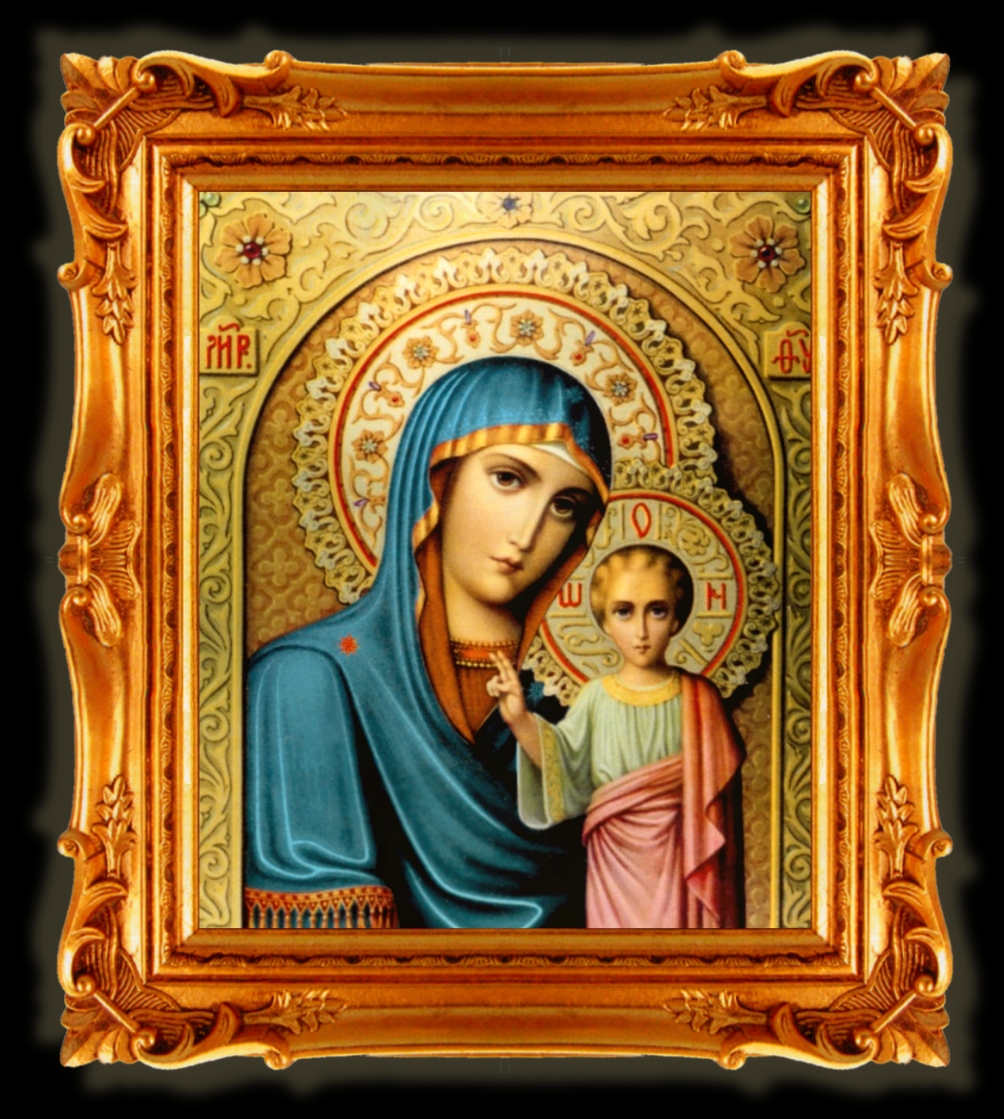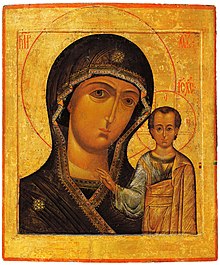The copy of Our Lady of Kazan given by Pope Bl. John Paul II to the Russian Church
Our Lady of Kazan (Virgin of Kazan, Theotokos of Kazan), Казанская Богоматерь (Kazanskaya Bogomater: "Theotokos of Kazan") in Russian, is a close-up version of a Hodigitria icon that is one of the most venerated icons in the Russian Orthodox Church. It is difficult to determine the exact history of this icon due to the many copies that were made of it. Of the numerous ancient copies that exist today, there is still debate which one (if any) is the original.
According to tradition, the icon came to Kazan (a city in Russia) from Constantinople in the 13th century. When Kazan was besieged by the Tartars in 1438, the icon disappeared until it was found buried in a garden by a young girl named Matrona on July 8, 1579, after the location was revealed by the Theotokos in a prophetic dream. The icon was placed in the Church of St. Nicholas in Kazan, where it cured a blind man the next day; not only that, but the priest at this church, Hermogen, eventually became Patriarch of Moscow and All Russia. It was by his doing, after his becoming Metropolitan of Kazan, that the icon was moved to the city's Cathedral of the Annunciation and July 8 was declared the feast day of Our Lady of Kazan.
In the centuries following, the icon (or a copy of it: there is debate) was processed and venerated during numerous military conflicts (including the Polish invasion of 1612, the Swedish invasion of 1709, and Napoleon's invasion of 1812), and Russia's success in these battles was attributed to the intercession of Our Lady of Kazan (thus adding nationalistic connotations to the icon). During this time, the icon (or copy) was placed in increasingly more prestigious locations, first in a small chapel to the Virgin of Kazan built in the Moscow Kremlin, then, in 1638, to the Kazan Cathedral built for it in Moscow, and eventually, in 1812, after Napoleon's invasion, to a Kazan Cathedral built in St. Petersburg.
From this time, the history becomes even more clouded, especially since many copies were written, and nine or ten of these became wonder-working. The copy in Kazan was stolen on June 29, 1904, and the copy in St. Petersburg disappeared after the October Revolution of 1917. (According to some, this latter copy disappeared en route to Moscow and eventually turned up in New York City.) There is a report that a copy was processed during the Siege of Leningrad in World War II.
The most famous copy of the icon today is one from around 1730 that was acquired by the Blue Army of Our Lady of Fatima and enshrined in Fatima in the 1970s. (One source says this is the same copy as the one that disappeared from St. Petersburg around 1917 or 1918.) Wishing to return the icon to the Russia, Pope Bl. John Paul II was given this icon in 1993, after which it was placed in his private study for eleven years. The Pope wanted to personally return the icon to the Russian Orthodox Church, but when his efforts failed, he instead gave the icon unconditionally to the Russian Church on August 26, 2004, when it was sent to Moscow after being venerated on the altar of St. Peter's Basilica. (One source says the Pope in the end sent the icon instead of continuing to try to return it personally because he knew he was near death.) The icon is now enshrined (next to a relic of the Virgin Mary's robe) in the Church of the Elevation of the Holy Cross in Kazan, part of the former Monastery of the Theotokos, which was built on the spot of the original finding of the icon by Matrona in 1579. Kazan is now being turned into a pilgrimage site for all religions (since not only the Orthodox, but Catholics and even Muslims have a devotion to Our Lady of Kazan) which will hopefully help bring peace between them. Our Lady of Kazan has two festal days for the Russian Orthodox: July 8th celebrates the Appearance of the Kazan Icon of the Mother of God in 1579, and October 22nd celebrates the Deliverance of Moscow From the Poles by the Kazan Icon in 1612.
In addition to the famous copy now in Kazan, there are two icons written in a style similar to Our Lady of Kazan that are now famous and wonder-working. Our Lady of Sitka is attributed to the famous 18th and 19th century portrait painter Vladimir Lukich Borovikovsky. Workers at the Russian-American Company gave the icon to the Cathedral of St. Michael the Archangel in Sitka, Alaska, in 1850. It was originally part of the main iconostasis of the cathedral, but due to the many miracles attributed to it, it was eventually relocated to a special place of honor on the far left of the iconostasis. It is also commemorated, along with Our Lady of Kazan, on July 8th.
Our Lady of Sitka
Our Lady of Soufanieh is in the Soufanieh neighborhood of Damascus, Syria. The icon itself is a small replica of Our Lady of Kazan bought in Sofia, Bulgaria, in 1980. The owner of the icon is Myrna Nazzour, a Greek-Melkite Catholic mystic who has reportedly had five apparitions of the Virgin Mary (1982-1983), many ecstasies in which she received messages from Jesus Christ and the Blessed Mother, and five occurrences of the stigmata. (As a side note, Myrna's messages from Christ and the Blessed Virgin received a Nihil Obstat from her bishop in 1987.) Before all these experiences (except for one experience of Myrna's own body exuding oil during prayer), on November 27, 1982, the icon of the Virgin of Kazan began to exude oil. Until November 26, 1990, the icon exuded oil following the rhythm of the liturgical year (except for a period from November 27, 1985, to November 25, 1986). The icon exuded oil once again during Holy Week of the year 2001. Aside from the original icon owned by Myrna, many photographic reproductions and replicas of the icon have exuded oil as well. This oil has caused numerous miracles.
Our Lady of Soufanieh
In conclusion to this rather long post, let us ask for the prayers of Our Lady of Kazan, and let us especially pray through her intercession for the reunion of the Russian Orthodox Church with Rome.
Our Lady of Kazan, save us!
Nota Bene: I consulted many websites for information on this post: Wikipedia, Orthodox Wiki, Ikons - Windows Into Heaven, Cleansing Fire, the Antiochian Orthodox Christian Archdiocese, the Orthodox Church in America (for feast day information), and Our Lady of Soufanieh.
Text ©2012 Brandon P. Otto. Licensed via CC BY-NC. Feel free to redistribute non-commercially, as long as credit is given to the author.


No comments:
Post a Comment